Colors speak to everyone, helping to raise awareness about important issues. When you see a pink ribbon, you immediately think of breast cancer awareness. Red ribbons bring HIV/AIDS awareness to mind. But what color represents mental health, and why does it matter?
Overview
Mental health impacts everyone, but stigma and misunderstanding keep many from getting help. The National Institute of Mental Health says that almost one in five adults has a mental illness each year. Our Mental Health Issues Guide helps you understand these conditions. They deserve the same support as physical health issues.
Awareness campaigns are key to reducing stigma. They teach communities, link people to resources, and motivate those in need to ask for help. Visual symbols like colors and ribbons create instant recognition. They spark conversations and show solidarity with those affected.
The Role of Colors in Symbolizing Emotions, Causes, and Advocacy
Humans have given colors meaning over time. These meanings come from psychological links and cultural importance. Colors influence emotions, trigger memories, and communicate messages without words. They are great tools for advocacy movements. They help convey complex ideas in a way that is both memorable and efficient.
Health awareness campaigns use color symbolism. This helps create a clear visual identity. People can easily recognize and support these campaigns. When communities come together for awareness months, they show support through colors. This helps those in need feel less alone.
Why Colors Are Powerful Tools for Mental Health Campaigns
The mental health awareness color serves many important functions. It gives quick visual recognition for mental health causes. It unites advocates and supporters. It offers easy ways for people to show support. It helps reduce stigma by increasing visibility. Plus, it sparks conversations about mental health topics.
Wearing a green ribbon or colors for mental health shows you're open to talking about it. It also shows support for those facing challenges. This visibility is crucial for those who suffer in silence. It shows them that help and understanding are out there.
What Is the Mental Health Awareness Color?
Knowing the official color for mental health awareness helps you support efforts more effectively.
Definition and Explanation of the Official Color
Green serves as the primary mental health awareness color recognized globally. The green ribbon is a mental health symbol. It shows up every May for Mental Health Awareness Month. You can also see it at mental health events throughout the year. Major mental health organizations use it in their campaigns worldwide.
When you see green ribbons, green lights on buildings, or people in green, they support mental health awareness. These signs show care for those affected by mental health conditions. This unified color choice creates consistency that strengthens recognition and impact.
Historical Background of How Green Became the Color for Mental Health
The green mental health awareness ribbon started in the 1990s. Mental health advocates wanted a unique color for their cause. Many organizations began using green for mental health campaigns. This choice grew in popularity as more groups joined in.
Mental Health America, a top mental health group in the U.S., helped make green the color for mental health. Using green in their materials, campaigns, and events made it a well-known symbol.
The selection of green wasn't arbitrary. Advocates picked this color for its positive links to mental health. It symbolizes recovery and wellness.
What the Color Green Symbolizes
Green symbolizes many strong ideas, making it perfect for mental health awareness. In nature, green represents growth and new beginnings as plants sprout and flourish. It represents renewal and the life cycle. This shows that mental health recovery is all about ongoing growth and renewal.
Green brings balance and harmony. It sits in the center of the color spectrum, between warm and cool tones. This balance mirrors the equilibrium people seek in mental health. Green stands for hope. This is important for anyone dealing with mental health issues or supporting loved ones in difficult times.
Green has a calming effect. This makes it a good choice for showing mental health in psychology. Green helps reduce stress and boost feelings of peace. This fits well with mental wellness goals.
The Meaning Behind Green in Mental Health
Green's role as the mental health awareness color goes beyond mere symbolism. It includes important emotional and psychological connections.
Emotional and Psychological Associations of Green
Green connects us to nature. It brings to mind forests, gardens, and open spaces. Many people find peace and restoration in these natural places. This connection to nature's healing power makes green meaningful for mental health representation.
Green promotes feelings of safety, security, and stability in a psychological context. Seeing green in mental health settings can make people feel stable and safe during treatment and recovery.
Green also represents vitality and life force. For people dealing with depression or similar problems, green stands for renewed energy and a link to life. It symbolizes the vitality that recovery can bring.
How It Represents Recovery, Support, and Breaking Stigma
The mental health color meaning shows that recovery is a journey, not a destination. Mental health recovery, like plant growth, involves steady progress. There are ups and downs, but each setback leads to renewed efforts. Green captures this process perfectly.
Support shows through green's association with compassion and caring. When communities wear green for awareness campaigns, they show support. This includes people facing mental health conditions and those helping loved ones.
Breaking stigma requires visibility and conversation. The distinctive green ribbon (mental health symbol) creates opportunities for these conversations. A green ribbon sparks conversations about mental health that may not happen otherwise.
Mental health includes many unique challenges. Conditions like Depression and Bipolar Disorder highlight this diversity. Each condition deserves support and understanding, symbolized by the green awareness color.
Use of Green Ribbons and Symbols in Awareness Events
Mental health awareness ribbons are common in May. This month is known as Mental Health Awareness Month.
Organizations promote wearing green ribbons, showing green lights, and using green on social media to show support.
World Mental Health Day, observed on October 10th each year, highlights green. Communities worldwide organize events, share resources, and promote mental health education. Using green consistently helps create global recognition and unity.
Local communities hold walks, runs, and gatherings where participants wear green. This raises awareness and funds for mental health services. These visible displays support normal conversations about mental health and honor those affected.
Awareness Colors Related to Mental Health
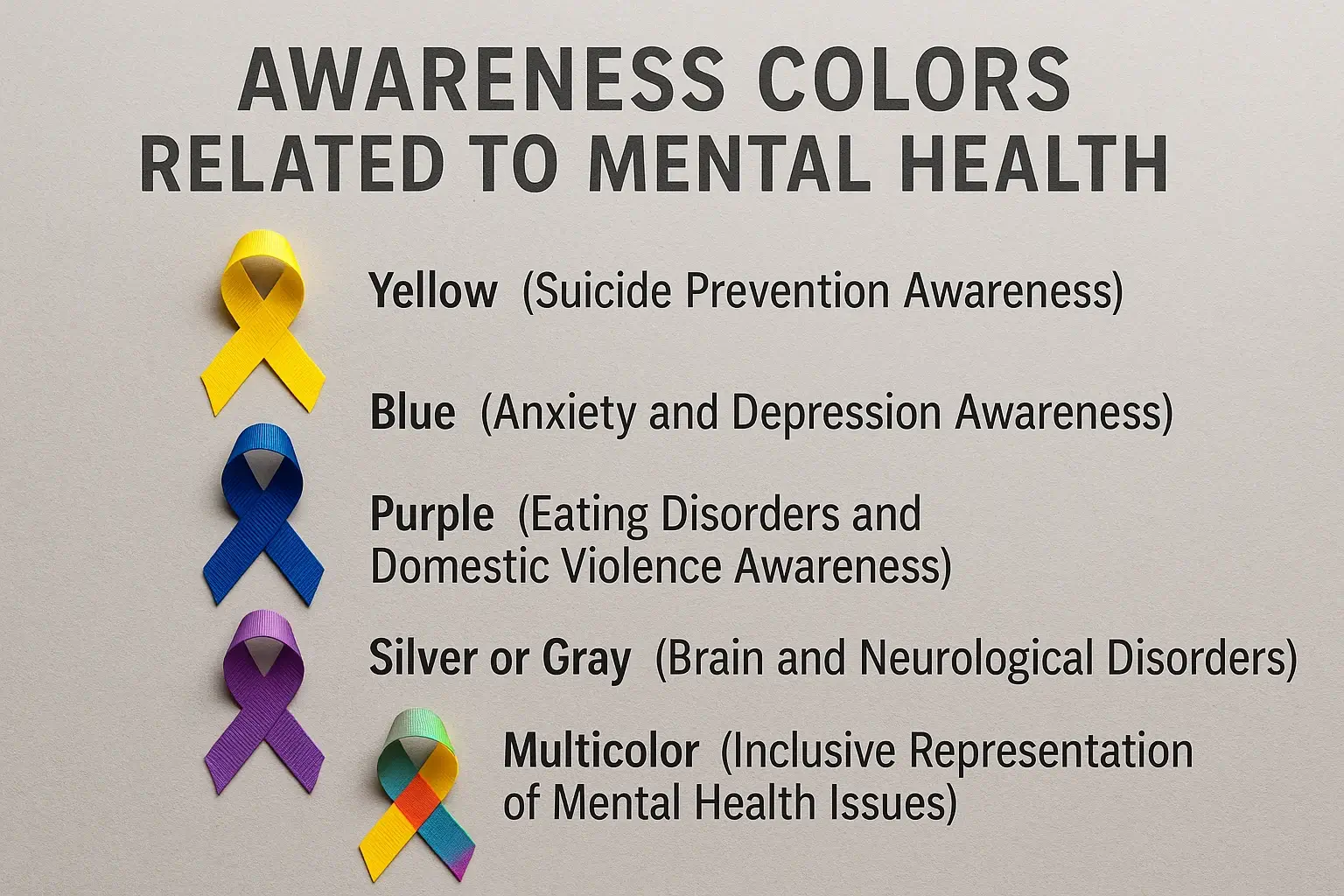 Green shows general mental health awareness. But specific conditions use other colors for targeted advocacy.
Green shows general mental health awareness. But specific conditions use other colors for targeted advocacy.
Yellow (Suicide Prevention Awareness)
The yellow ribbon symbol highlights the urgent mental health crisis of suicide. Yellow stands for hope and light, making it impactful for prevention messages. September is Suicide Prevention Awareness Month. Yellow is used in many campaigns and events.
Groups dedicated to suicide prevention use yellow to stand out from general mental health awareness. This helps them teach people about warning signs, risk factors, and resources. It supports those with suicidal thoughts and those concerned about loved ones.
Blue (Anxiety and Depression Awareness)
Blue appears in various mental health awareness contexts, particularly around anxiety and depression. Blue helps calm anxiety, while darker blues can show the weight of depression.
Some groups use light blue for mental health awareness. Others use it just for anxiety or depression campaigns. Understanding anxiety is easier with resources like our Complete Guide to Understanding Anxiety. This guide helps people spot symptoms and find the right help.
Purple (Eating Disorders and Domestic Violence Awareness)
Purple mental health awareness supports eating disorder advocacy. This is especially important during National Eating Disorders Awareness Week. The color stands for dignity, spirituality, and transformation. These ideas are important for recovery from eating disorders.
Purple stands for domestic violence awareness. It highlights the serious mental health effects of abuse and trauma. This dual use acknowledges the connections between trauma and mental health conditions.
Silver or Gray (Brain and Neurological Disorders)
Silver and gray represent brain health, neurological disorders, and conditions like Alzheimer's disease. These colors show the brain's role in mental health. They highlight that mental health is shaped by both mind and brain factors.
Understanding our guide to What Is a Psychiatric Disorder shows how brain function, chemistry, and structure impact mental health and wellness.
Multicolor Awareness (Inclusive Representation of Mental Health Issues)
Some advocates use rainbow or multicolored ribbons. These represent the full range of mental health conditions and experiences. This inclusive approach recognizes that mental health includes many different situations. Each one deserves attention and support.
Multicolor symbolism shows diversity in mental health communities. It honors various experiences, backgrounds, and journeys to wellness. Our article on Mental Health Recovery Symbols explores how people share their journeys. It covers different symbols and their meanings.
Global Mental Health Awareness Campaigns Using Colors
Color symbolism appears consistently across major mental health awareness initiatives worldwide.
Key Events: Mental Health Awareness Month
Mental Health Awareness Month happens every May in the United States. It’s the biggest annual campaign for mental health. This month, the color green is everywhere for mental health awareness. You’ll see it in social media campaigns and on buildings lit up across cities.
Organizations release educational materials, host events, and encourage open conversations about mental health. Using green consistently helps deliver a clear message. It boosts impact in different communities and groups.
Resources for groups like Women's and Men's Mental Health Awareness Month highlight their unique challenges. Mental health awareness needs to address these differences.
World Mental Health Day
October 10th is World Mental Health Day. It draws global attention to mental health, organized by the World Health Organization. This international observance primarily features the color green. It also adds local cultural elements and themes each year.
World Mental Health Day campaigns connect with millions globally. They use the day's color for easy recognition. This helps break down language and cultural barriers. Each year, the day highlights different themes. It looks at various aspects of mental health and wellness.
Organizations Using Color Symbolism in Campaigns
Mental Health America, NAMI, and other groups use green in their branding. This consistency helps people recognize the mental health advocacy movement. It also creates clear messages.
International organizations adopt similar color symbolism, creating global recognition that transcends geographic boundaries. Mental health advocates across countries use the same colors. This boosts their collective impact and shows that mental health is important everywhere.
How Communities and Individuals Show Support Using Colors
People show support for color-based awareness by:
- Wearing green clothes or ribbons during awareness months.
- Changing social media profile pictures to add green ribbons or filters.
- Displaying green lights at homes and businesses.
- Organizing community events that highlight green issues.
Schools and workplaces hold "Green Days." On these days, everyone wears green. This shows support for mental health and encourages conversations about it. These acts of solidarity cut stigma. They also show those in need that support and understanding are all around them.
How to Use Mental Health Awareness Colors
Using awareness colors in daily life enhances their impact and spreads mental health messages widely.
Ideas for Wearing, Decorating, or Designing with Awareness Colors
Wearing green for mental health awareness can be simple or creative.
- Pin green ribbons on your clothes.
- Wear all-green outfits for awareness events.
- Choose green accessories like scarves, ties, or jewelry.
- Use green in your makeup or nail polish.
Decorating spaces with green shows support while creating a visual impact. Use green balloons, streamers, or banners at events. Add green lighting to buildings or homes. Create green ribbon displays in offices or public spaces. Arrange green flowers or plants as centerpieces.
Designing with mental health awareness colors in digital and print materials spreads awareness broadly.
- Create social media graphics with green ribbons and awareness messages.
- Design posters or flyers for community education that feature green prominently.
- Develop website banners or profile pictures that use green symbolism.
Using Color Symbolism in Schools, Workplaces, and Online Campaigns
Schools can organize awareness weeks featuring daily activities around mental health themes with green decorating hallways and classrooms. Educators can include lessons on mental health. They can teach students about awareness of colors and what they mean. Also, they should encourage student-led campaigns that use color symbolism.
Understanding mental health in young people is crucial. Resources like our Guide to Anxiety in Kids help schools meet student needs. They also promote awareness and compassion.
Workplaces support...
We promote mental health through color by:
- Organizing awareness events during Mental Health Awareness Month.
- Encouraging employees to wear green on specific days.
- Displaying mental health resources in common areas with green materials.
- Using mental health awareness colors in wellness program branding.
Online campaigns support mental health awareness in several ways. They use coordinated hashtag campaigns with green themes. They create shareable graphics in awareness colors. Supporters are encouraged to change their profile pictures to include green ribbons. Events are livestreamed with green backgrounds or lighting.
Incorporating Colors into Logos, Ribbons, Posters, and Digital Graphics
Organizations and individuals making mental health materials should know the color codes. This will help them use the codes effectively. Standard green values for digital use often include hex codes. For example, lime green is #39FF14, and jade green is #00A86B. However, there are variations.
Design considerations include:
- Ensuring green contrasts well with other colors for readability.
- Using ribbon shapes to reinforce awareness symbolism.
- Balancing green with neutral colors to keep designs from being overwhelming.
- Maintaining consistency across materials for easy recognition.
Psychological Impact of Colors on Mental Health
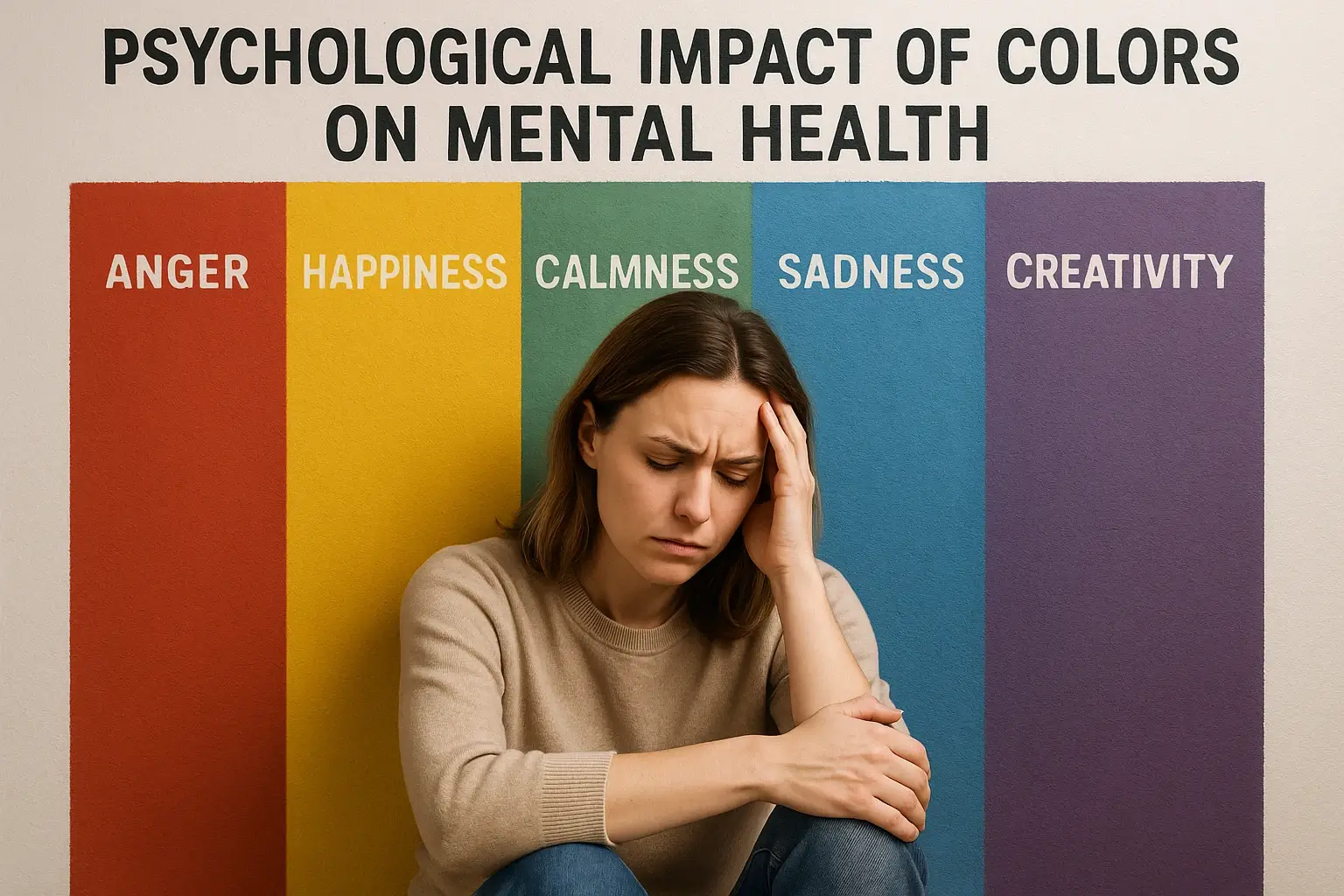 Beyond symbolism, colors genuinely affect emotional states and mental wellness.
Beyond symbolism, colors genuinely affect emotional states and mental wellness.
How Different Colors Affect Emotions and Behavior
Color psychology research demonstrates that colors influence mood, energy, and even physical responses. Green calms and eases stress. This makes it useful, not just for its mental health symbol. Blue typically produces relaxing effects while improving focus and concentration.
Warm colors, like yellow and orange, can boost energy and improve mood. They may help ease depression symptoms. However, excessive warm colors might increase anxiety in some individuals. Colors can affect our minds. Some colors are tied to specific mental health issues. Learning about these links helps us understand their impact better.
Red can raise heart rate and spark feelings of urgency or excitement. This may be too much for those with anxiety. Purple mixes the calm of blue with the energy of red. This balance helps with introspection and emotional processing.
Using Colors in Therapy, Environments, and Mindfulness Practices
Therapists increasingly incorporate color intentionally into treatment spaces and therapeutic activities. Offices in calming colors like soft green or blue help clients relax during sessions. Art therapy uses colors to help people express feelings that are hard to articulate.
Our Art Therapy Ideas for Mental Health resource shows how creative expression, like using colors, aids mental health recovery and emotional processing.
Environmental color choices in homes, schools, and workplaces significantly impact mental wellness. Bedrooms enjoy calming colors that promote restful sleep. Work environments can use energizing colors to boost focus. However, they should use them in moderation to prevent overstimulation.
Mindfulness practices often include color meditation. In this, people focus on certain colors while breathing. They visualize these colors to boost their emotions. Also, noticing colors in nature helps them stay present and lower stress.
The Science Behind Color Psychology and Emotional Healing
Neuroscience shows that seeing colors involves complex brain processes. These processes link what we see to our emotions. When you see green, your brain goes beyond just recognizing the color. It also triggers memories, associations, and feelings tied to green from your life.
This brain link shows why color can truly affect mood and stress, not just symbolize ideas. Spending time in green spaces can lower cortisol levels and slow heart rates. The calming effect of green is clear.
Understanding how different factors affect mental health is key. Environmental influences, highlighted in our Acquired Psychiatric Disorders content, play a role. This knowledge helps us build better wellness strategies. Thoughtful use of color can be a part of these approaches.
Supporting Mental Health Awareness Through Colors
Awareness colors help reduce stigma and boost mental wellness. Both individual and group actions make a real difference.
How to Participate in Color-Based Awareness Activities
Participation begins with learning about awareness colors and their meanings. Then, share this knowledge with others. During May, wear green to work, school, or social events and explain why when people ask. This creates organic conversations about mental health.
Join events like mental health walks or runs. Wear colors that show your support. These gatherings build community while raising funds and awareness simultaneously. Change your social media profiles during awareness periods. Join online campaigns and share educational content with green graphics.
Support isn’t just for awareness months. It continues all year long. You can show your support by displaying green ribbons on cars or bags. Also, keep talking about mental health anytime, not just during specific months.
Raising Awareness Through Social Media and Community Events
Social media significantly enhances awareness when users apply thoughtful consideration.
- Share what different mental health colors mean.
- Post personal stories about your mental health journey and related colors.
- Use relevant hashtags to join bigger movements.
- Engage with mental health organizations to help extend their reach.
Community events can include:
- Mental health fairs with green decorations and materials.
- Educational workshops about mental health using color-themed resources.
- Fundraising activities in which participants wear awareness colors.
- Collaborative art projects in public spaces featuring mental health colors.
Natural ways to manage mental health, like those in How to Calm Anxiety Naturally, provide useful tools. These tools help people act right away while raising awareness.
Encouraging Conversations and Inclusivity Through Symbolic Colors
Colors spark conversations that might be hard or awkward to start. Wearing a green ribbon lets others know they can share their feelings or worries. This simple act of visibility contributes to normalizing mental health discussions.
Inclusivity means recognizing that mental health awareness must embrace diverse experiences and conditions. Using different colors shows various conditions. The green color stands for support for all mental health. This approach ensures that people with multiple conditions feel represented and supported.
Creating safe spaces for conversations means:
- Listening without judgment when someone shares their mental health experiences.
- Validating feelings instead of dismissing concerns.
- Offering resources and support, not unsolicited advice.
- Recognizing that mental health journeys differ for everyone.
Conclusion
Mental health awareness colors, especially green, are strong symbols. They unite advocates, lower stigma, and start important talks about mental wellness. Knowing what colors stand for mental health is important. It helps people join awareness efforts in a more meaningful way.
The green ribbon is a symbol for mental health. It stands for hope, growth, and renewal. It also reflects the ongoing journey to mental wellness that many people face each day. Wearing green for Mental Health Awareness Month and all year shows that we value mental health. Learning about what these colors mean also makes a difference. This supports those affected by mental health conditions.
Colors offer easy ways for everyone to join mental health advocacy. Anyone can take part, no matter their resources or expertise. Using these symbols wisely helps us create caring communities. In these spaces, mental health gets the attention, understanding, and support it needs.
At Gendrics, we focus on mental health education. We help people understand, recognize, and address their mental health needs. Explore our resources to boost your understanding and support your mental health journey or that of a loved one.

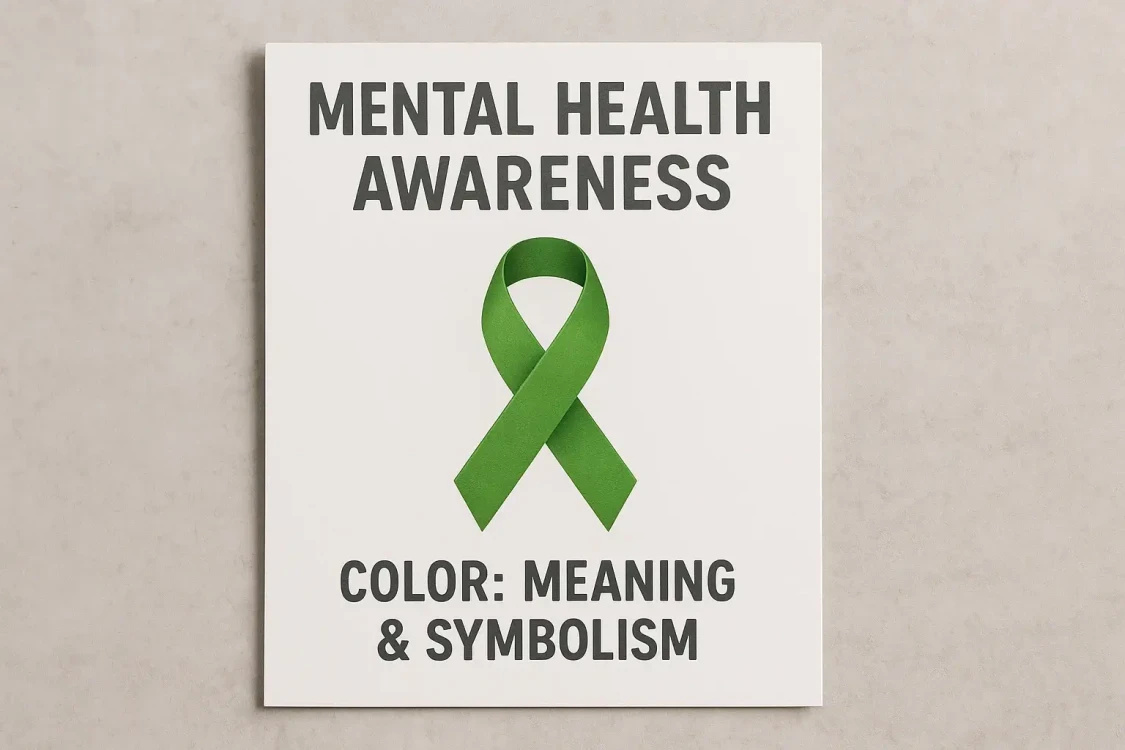
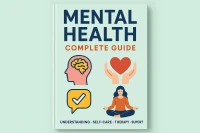
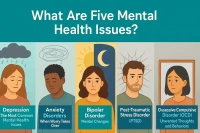

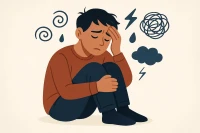
Comments